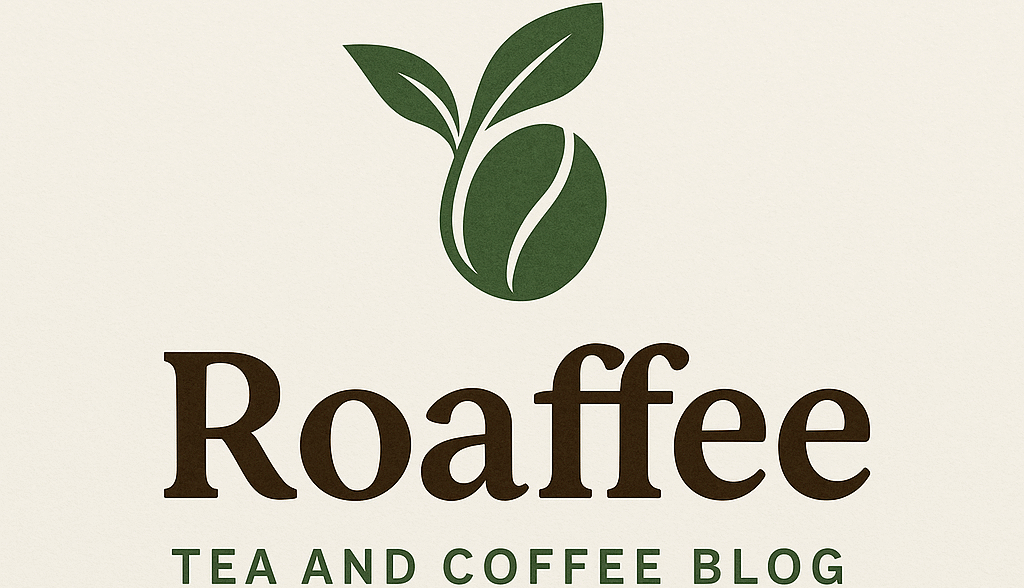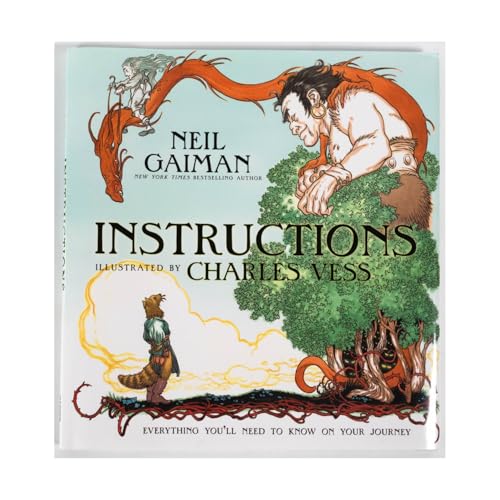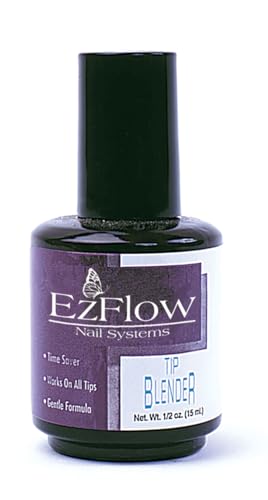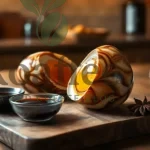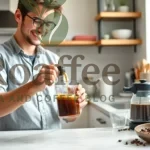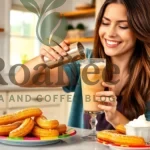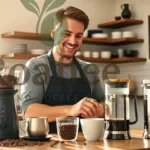There’s nothing quite like starting your morning with a perfectly brewed cup of coffee that rivals your favorite café. While coffee shops have mastered their create we’ve discovered that making exceptional coffee at home isn’t as complicated as you might think. With the right techniques and a few simple adjustments to your brewing routine you can transform your daily coffee experience.
The secret to great home-brewed coffee lies in understanding the fundamentals: quality beans proper water temperature and precise timing. We’ve spent countless mornings experimenting with different methods to bring you foolproof techniques that work with equipment you likely already own. Whether you’re using a drip coffee maker French press or pour-over setup these principles will elevate your coffee game.
Skip the expensive coffee shop runs and discover how satisfying it is to create your perfect cup at home. We’ll walk you through each step to ensure you get consistent delicious results every single time you brew.
Equipment Needed
Quality coffee starts with the right tools. We’ll walk you through both the essential equipment and optional upgrades that can elevate your brewing game.
Essential Coffee Brewing Equipment
The foundation of great coffee lies in having the basic tools that every home brewer needs. These items will help you achieve consistent results regardless of your brewing method.
Coffee Grinder
We recommend investing in a burr grinder over blade grinders for uniform particle size. Consistent grinding ensures even extraction and prevents bitter or sour flavors from uneven brewing.
Coffee Maker or Brewing Device
Choose from several reliable options:
- Drip coffee makers for convenience and larger batches
- French press for full-bodied coffee with minimal effort
- Pour-over setups like V60 or Chemex for precise control
- Espresso machines for concentrated coffee drinks
Kitchen Scale
Accurate measurements make the difference between good and exceptional coffee. We use a digital scale to measure both coffee beans and water for the perfect ratio every time.
Quality Water
Filtered water removes chlorine and impurities that can affect taste. Since coffee is 98% water, this simple step dramatically improves your final cup.
Timer
Precise timing controls extraction strength and prevents over-brewing. Most smartphones work perfectly for this purpose.
Optional Tools for Better Results
These additional tools can enhance your coffee-making experience and help you achieve professional-level results at home.
Gooseneck Kettle
Pour-over enthusiasts benefit from the precise water flow control that gooseneck kettles provide. The narrow spout allows for circular pouring patterns that ensure even saturation.
Thermometer
Water temperature between 195°F and 205°F extracts the best flavors from your beans. A simple instant-read thermometer helps maintain this optimal range.
Coffee Storage Containers
Airtight containers preserve bean freshness by protecting against light, air, and moisture. We store our beans in opaque, vacuum-sealed containers for maximum flavor retention.
Milk Frother
Steam wands or handheld frothers create creamy texture for lattes and cappuccinos. Even a simple French press can froth milk when you pump the plunger vigorously.
Multiple Filters
Stock up on paper filters for your exact brewing device. Different filter types affect taste and brewing time, so having extras ensures you never run out mid-brew.
Ingredients
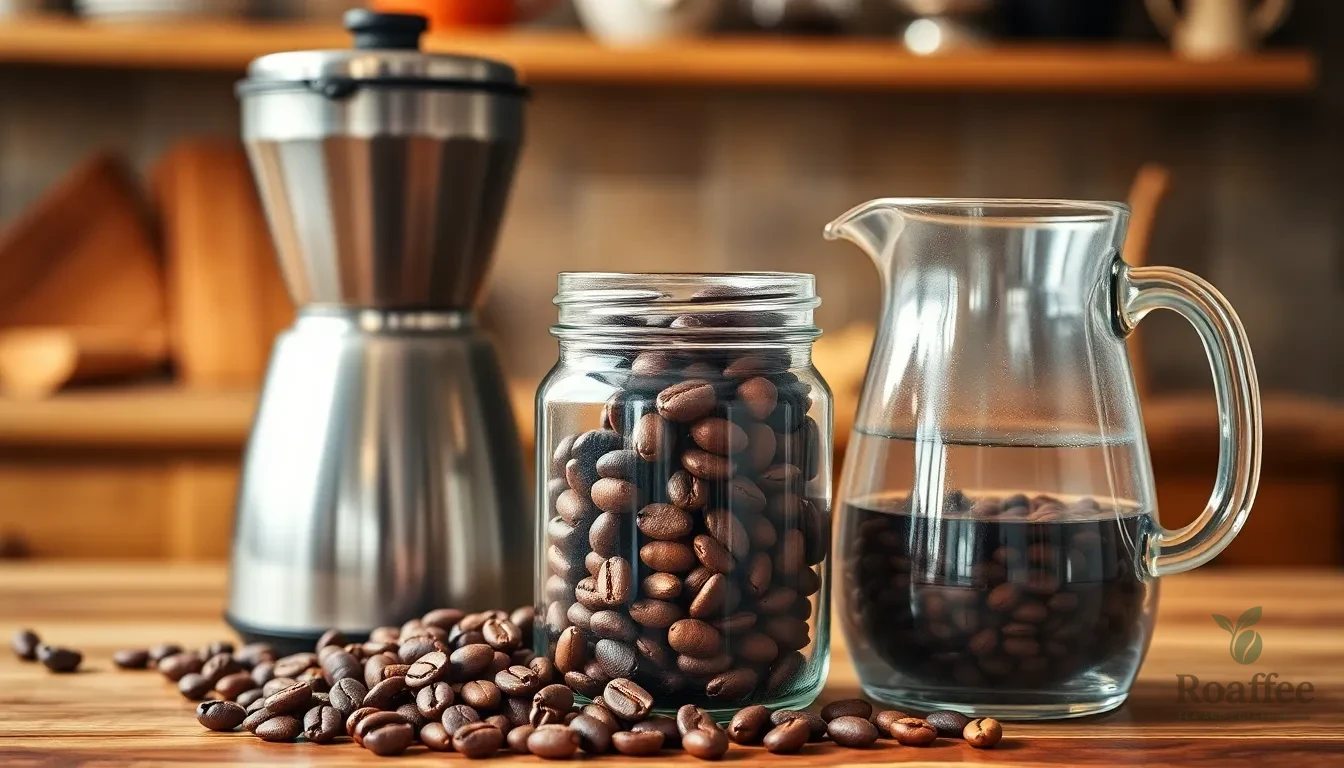
Great coffee starts with selecting the right ingredients before you even touch your brewing equipment. We focus on two fundamental components that determine whether your home brew will be exceptional or disappointing.
Coffee Beans Selection
We recommend starting with freshly roasted whole beans for the best flavor profile. Look for beans with a roast date within two to four weeks of purchase to ensure optimal freshness. Medium roast beans offer balanced acidity and body that work well for most brewing methods.
Bean Selection Criteria:
- Origin: Single-origin beans showcase unique flavor characteristics from exact regions
- Roast level: Light roasts preserve origin flavors while dark roasts develop bold smoky notes
- Processing method: Washed beans provide clean bright flavors while natural processed beans offer fruity sweetness
- Grind timing: Always grind beans just before brewing to preserve essential oils and aromatics
We suggest buying beans from local roasters who can provide detailed information about origin and processing methods. Store whole beans in an airtight container away from light and heat to maintain freshness for up to four weeks.
Water Quality Requirements
Water comprises over 98% of your coffee so its quality directly impacts the final taste. We use filtered water with balanced mineral content to extract the best flavors from your beans.
Water Quality Standards:
| Parameter | Ideal Range | Impact on Coffee |
|---|---|---|
| TDS (Total Dissolved Solids) | 150-300 ppm | Extraction efficiency |
| pH Level | 6.5-7.5 | Acidity balance |
| Hardness | 4-8 dGH | Mineral extraction |
| Chlorine | 0 ppm | Flavor interference |
Tap water often contains chlorine and excessive minerals that create off flavors in your coffee. We recommend using filtered water or bottled water with neutral pH levels. Distilled water lacks minerals needed for proper extraction so avoid using it for brewing.
Test your water quality with simple strips available at most grocery stores. If your tap water tastes good on its own it will likely produce good coffee when properly filtered.
Preparation
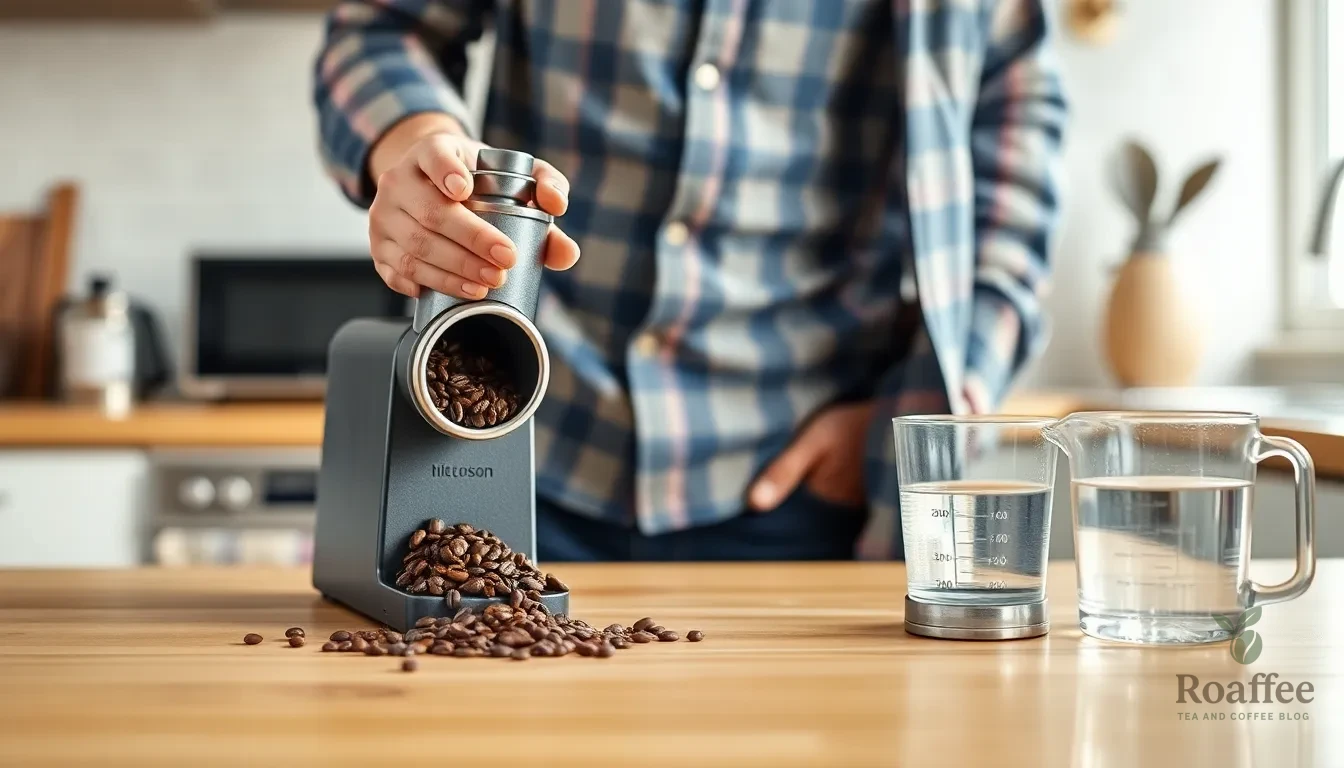
We set the foundation for exceptional coffee by focusing on three critical preparation steps. These elements work together to create the optimal conditions for brewing your perfect cup.
Choosing the Right Coffee Beans
We select beans that complement our brewing method and personal taste preferences. Light roasts showcase bright acidity and complex flavors while medium roasts offer balanced sweetness and body. Dark roasts deliver bold smoky notes with reduced acidity.
We examine the roast date printed on the package and choose beans roasted within the past two to four weeks. Fresh beans contain essential oils that create rich flavor profiles and proper extraction. We avoid pre-ground coffee since it loses flavor compounds within hours of grinding.
We consider single-origin beans for distinctive regional characteristics or blends for balanced complexity. Ethiopian beans provide floral notes while Colombian beans offer caramel sweetness. Brazilian beans contribute chocolate undertones and Central American varieties present bright citrus flavors.
We store our beans in airtight containers away from light and heat to preserve freshness. Room temperature storage maintains optimal flavor while refrigeration can introduce moisture that degrades quality.
Grinding Your Coffee Beans
We grind our beans immediately before brewing to capture peak flavor and aroma. Fresh grinding releases volatile compounds that create the complex taste profile we desire in our coffee.
We adjust our grind size based on our brewing method for optimal extraction. Coarse grinds work best for French press brewing while medium grinds suit drip coffee makers. Fine grinds complement pour-over methods and extra-fine grinds enhance espresso preparation.
We use a burr grinder to achieve uniform particle size that ensures even water contact with all coffee grounds. Blade grinders create inconsistent pieces that lead to over-extraction of fine particles and under-extraction of larger chunks.
We measure our coffee using a kitchen scale for precision rather than volume measurements. Coffee beans vary in density so weighing provides consistent results across different origins and roast levels.
Water Temperature and Measurement
We heat our water to the optimal temperature range between 195°F and 205°F for proper extraction. Water that is too hot burns the coffee and creates bitter flavors while cooler water under-extracts and produces weak taste.
We use a thermometer or temperature-controlled kettle to maintain consistent heat throughout the brewing process. Boiling water reaches 212°F so we allow it to cool for 30 seconds before pouring over our grounds.
We maintain the ideal coffee-to-water ratio for balanced strength and flavor extraction:
| Brewing Method | Coffee-to-Water Ratio | Coffee Amount | Water Amount |
|---|---|---|---|
| Drip Coffee | 1:15 | 1 gram | 15 grams |
| French Press | 1:12 | 1 gram | 12 grams |
| Pour-Over | 1:16 | 1 gram | 16 grams |
| Espresso | 1:2 | 1 gram | 2 grams |
We measure both coffee and water using a digital scale for accuracy since volume measurements can vary significantly. Consistent ratios ensure reproducible results and help us fine-tune our brewing technique over time.
We use filtered water with balanced mineral content to enhance flavor extraction without introducing unwanted tastes. Hard water with excessive minerals creates harsh flavors while soft water lacks the minerals needed for proper extraction.
Instructions
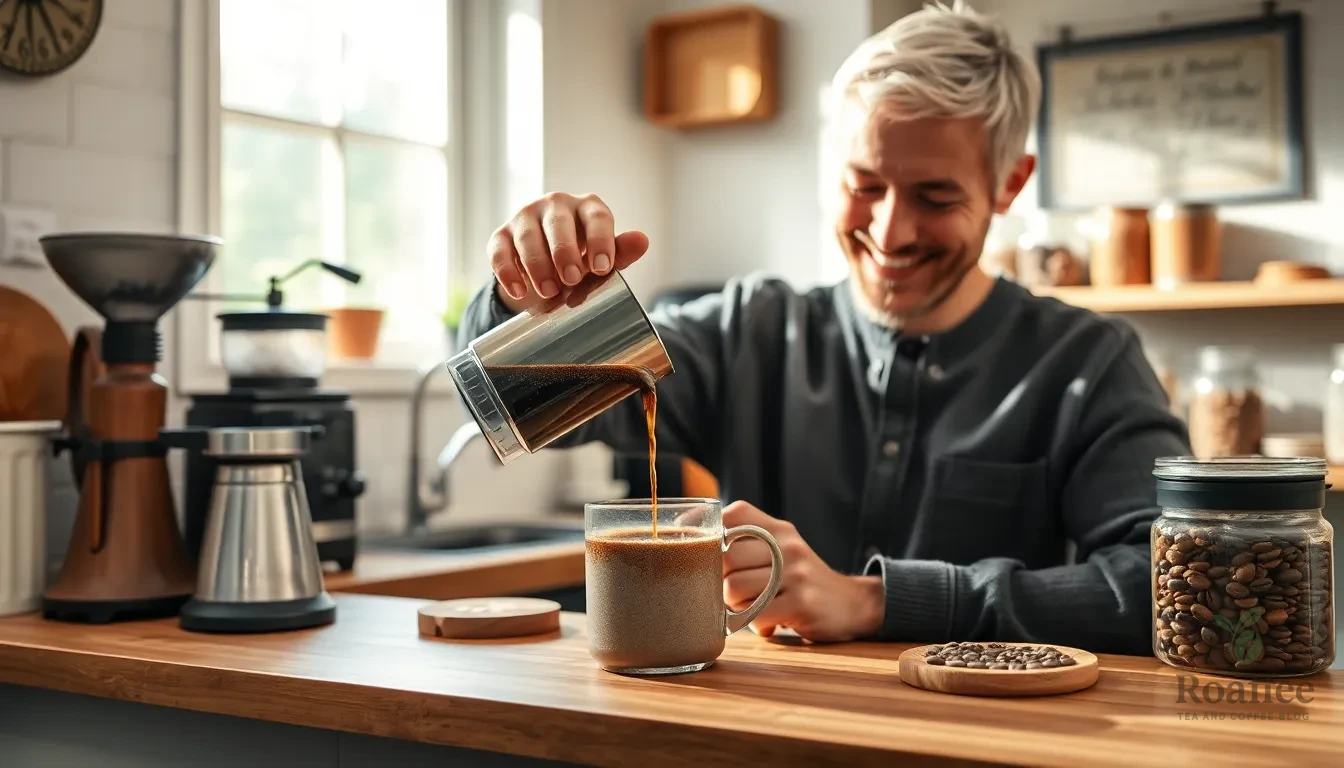
We’ll walk you through four proven brewing methods that consistently produce exceptional coffee at home. Each technique offers unique advantages and requires exact steps to achieve optimal flavor extraction.
French Press Method
We start by heating water to 200°F and adding coarsely ground coffee to the French press using a 1:15 coffee-to-water ratio. Pour a small amount of hot water over the grounds to bloom them for 30 seconds. This allows the coffee to release trapped gases and prepares it for even extraction.
Next we add the remaining water in a slow circular motion to ensure all grounds are saturated. Place the lid on the French press with the plunger pulled up and let the coffee steep for 4 minutes. The longer steeping time allows for full flavor development with the coarse grind.
After 4 minutes we press the plunger down slowly and steadily to separate the grounds from the coffee. Serve immediately to prevent over-extraction. The French press method produces a full-bodied coffee with rich oils and bold flavors that many coffee enthusiasts prefer.
Pour Over Method
We begin by placing a paper filter in the pour over dripper and rinsing it with hot water to remove any papery taste. This also preheats the brewing vessel. Use a medium-fine grind and a 1:16 coffee-to-water ratio for optimal extraction.
Heat water to 200°F and add the ground coffee to the center of the filter. Start the timer and pour twice the weight of water as coffee in a slow spiral motion from the center outward. This blooming phase lasts 30 seconds and allows the coffee to degas.
Continue pouring in slow circular motions keeping the water level consistent. Pour in 2-3 additional stages with 30-second intervals between each pour. The total brewing time should be 3-4 minutes. The pour over method creates a clean bright cup with distinct flavor notes.
Drip Coffee Maker Method
We measure coffee using a 1:15 ratio and grind beans to a medium consistency similar to kosher salt. Use filtered water and ensure the coffee maker is clean before brewing. Add the ground coffee to the filter basket and level it for even water distribution.
Fill the water reservoir with cold filtered water and start the brewing cycle. The machine will heat the water and distribute it over the coffee grounds automatically. Most quality drip coffee makers maintain proper temperature and timing for consistent results.
Allow the full brewing cycle to complete before removing the carafe. The drip method produces a well-balanced cup with moderate body and clarity. We recommend brewing only what you’ll consume within 30 minutes to maintain optimal flavor and temperature.
Cold Brew Method
We combine coarsely ground coffee with room temperature water using a 1:8 ratio for concentrate or 1:12 for ready-to-drink strength. The coarse grind prevents over-extraction during the long steeping process. Mix the coffee and water thoroughly to ensure all grounds are saturated.
Cover the mixture and let it steep at room temperature for 12-24 hours. Longer steeping times create stronger concentrate while shorter times produce milder flavors. The extended contact time allows for smooth extraction without heat.
Strain the coffee through a fine mesh strainer lined with cheesecloth or use a dedicated cold brew maker. We recommend double-straining to remove all sediment. Cold brew concentrate can be stored in the refrigerator for up to two weeks and diluted with water or milk before serving. This method produces a smooth low-acid coffee perfect for hot weather or those sensitive to acidity.
Directions for Perfect Brewing
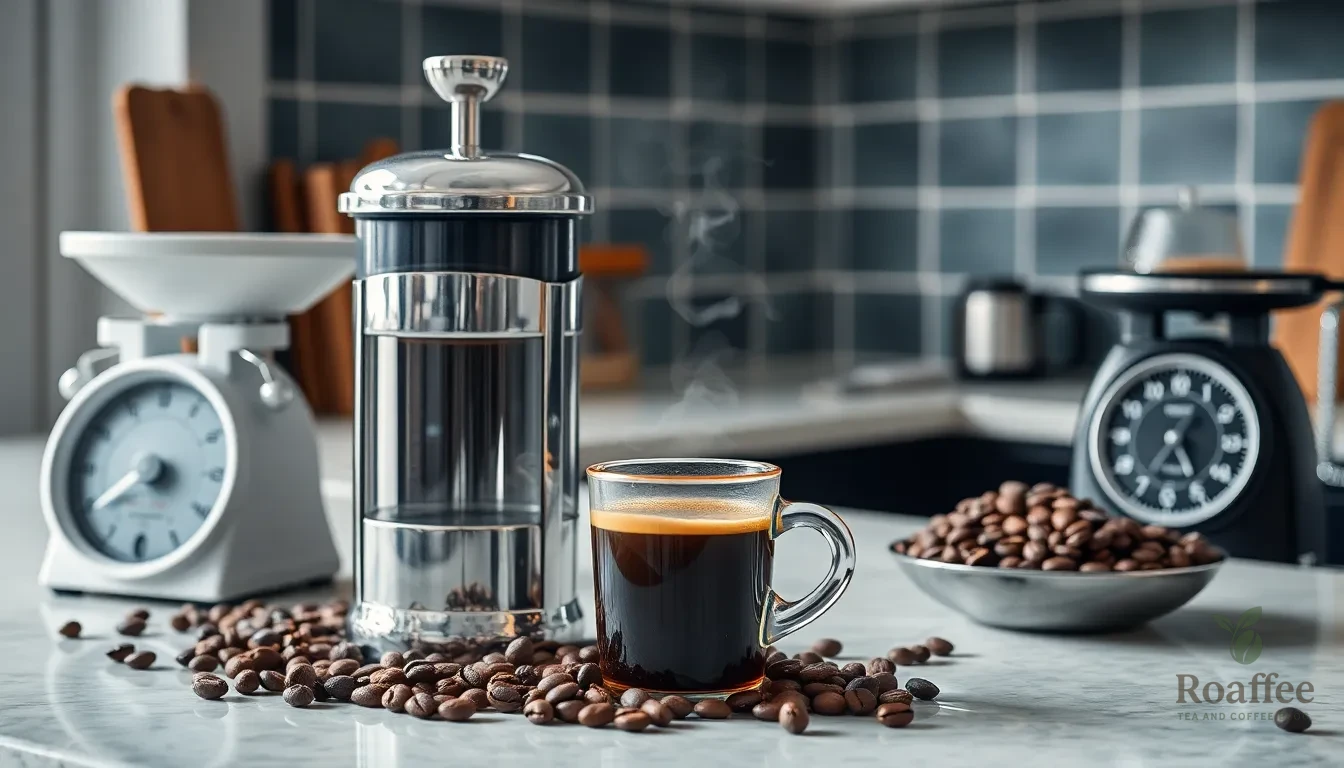
Mastering the brewing process requires precise attention to timing and proper extraction techniques. We’ll guide you through the essential elements that transform quality ingredients into exceptional coffee.
Timing Your Brew
Different brewing methods require exact timing to achieve optimal flavor extraction. French press brewing demands exactly 4 minutes of steeping time to develop full body without over-extraction. Pour over methods work best with a total brewing time of 3-4 minutes including the initial bloom phase of 30 seconds.
Drip coffee makers typically complete their cycle in 5-6 minutes for proper extraction. Cold brew requires the longest commitment at 12-24 hours of steeping time to create smooth concentrate. We recommend using a timer for consistency since even 30 seconds can significantly impact your coffee’s taste profile.
Proper Coffee-to-Water Ratio
Accurate measurements form the foundation of great coffee brewing. We use exact ratios customized to each brewing method for optimal strength and flavor balance.
| Brewing Method | Coffee-to-Water Ratio | Coffee Amount (per 8 oz water) |
|---|---|---|
| French Press | 1:15 | 0.53 oz (15g) |
| Pour Over | 1:16 | 0.5 oz (14g) |
| Drip Coffee Maker | 1:15 | 0.53 oz (15g) |
| Cold Brew (Concentrate) | 1:8 | 1 oz (28g) |
Kitchen scales provide the most accurate measurements since coffee beans vary in density. We measure both coffee and water by weight rather than volume for consistent results every time.
Extraction Techniques
Proper extraction depends on controlling water temperature and contact time between coffee and water. We heat water to 200°F for most brewing methods to achieve optimal extraction without burning the coffee grounds.
The bloom technique enhances flavor extraction in pour over methods. We pour twice the weight of water as coffee grounds over the bed and wait 30 seconds for degassing. This initial saturation allows for even extraction throughout the brewing process.
Agitation plays a crucial role in French press brewing. We stir the coffee grounds gently after adding water to ensure complete saturation. For pour over methods we use circular pouring motions to maintain even water distribution across the coffee bed.
Water flow rate affects extraction intensity. Slow steady pours in pour over methods allow for controlled extraction while fast aggressive pours can lead to uneven results. We maintain consistent pouring speed throughout the brewing process for uniform flavor development.
Storage and Maintenance
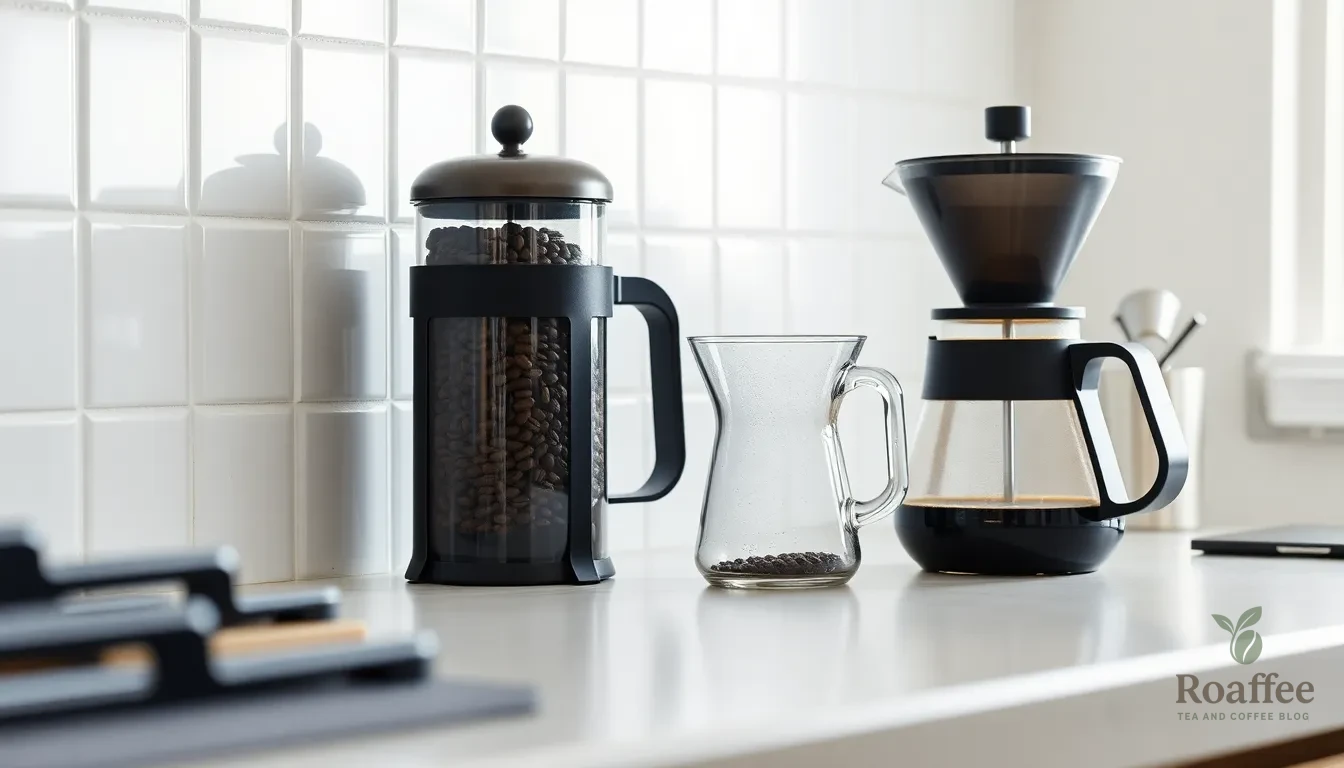
Proper storage and equipment maintenance are essential for preserving the quality of your coffee beans and ensuring consistent brewing results. We’ll guide you through the best practices for keeping your coffee fresh and your equipment in optimal condition.
Storing Coffee Beans Properly
We recommend storing your coffee beans in an airtight container away from light, heat, and moisture to maintain their freshness and flavor. The ideal storage location is a cool, dark pantry or cabinet where temperatures remain consistent.
Whole beans retain their quality for up to four weeks when stored properly, while ground coffee loses its freshness within a few days. We always keep our beans in their original packaging until ready to use if it has a one-way valve, as this packaging is specifically designed to protect the beans from oxygen exposure.
Avoid storing coffee in the refrigerator or freezer, as these environments create condensation that can damage the beans’ cellular structure and introduce unwanted moisture. Room temperature storage in a sealed container works best for preserving the oils and compounds that create exceptional flavor.
We transfer our beans to opaque, airtight containers immediately after opening the original packaging to prevent exposure to air and light. Glass jars with tight-fitting lids or specialized coffee storage containers with CO2 valves provide excellent protection.
Purchase coffee in quantities you can consume within two to four weeks to ensure optimal freshness. We buy smaller batches more frequently rather than large quantities that might sit too long and lose their vibrant flavors.
Cleaning Your Equipment
We clean our coffee equipment after each use to prevent oil buildup and maintain the pure taste of our coffee. Daily cleaning involves rinsing all removable parts with warm water and drying them thoroughly before storage.
French presses require disassembly of the plunger mechanism for proper cleaning, allowing us to remove coffee oils that can turn rancid and affect future brews. We wash the carafe, plunger, and filter screen separately with warm, soapy water.
Pour-over equipment needs attention to the filter holder and carafe, where coffee oils can accumulate over time. We rinse these components immediately after brewing and perform a deeper clean with baking soda solution weekly.
Drip coffee makers benefit from monthly descaling with white vinegar to remove mineral deposits that can affect water flow and temperature. We run a brewing cycle with equal parts water and vinegar, followed by two cycles of plain water to remove any residual taste.
Burr grinders require weekly cleaning to remove coffee oils and prevent them from turning rancid. We disassemble the grinding chamber and clean the burrs with a brush designed for coffee equipment, avoiding water on the motor components.
We perform deep cleaning of all equipment monthly using specialized coffee equipment cleaners or a mixture of warm water and baking soda. This process removes stubborn oils and ensures our equipment continues to produce exceptional coffee without off-flavors.
Troubleshooting Common Issues
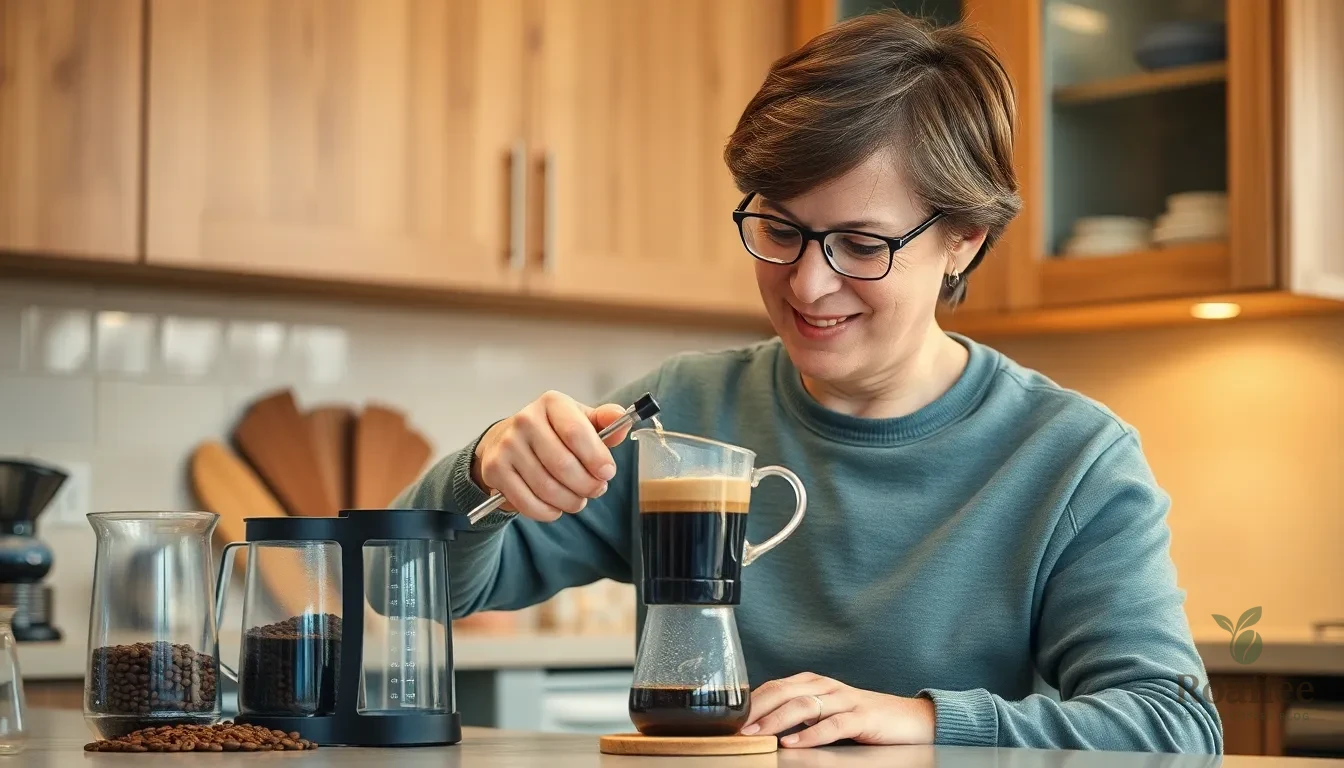
Even with careful preparation coffee brewing can sometimes produce disappointing results. We’ll address the most common problems and provide answers to help you achieve consistently delicious coffee at home.
Fixing Bitter Coffee
Over-extraction typically causes bitter coffee when brewing methods pull too many undesirable compounds from the coffee grounds. We start by adjusting the grind size to a coarser setting since finer grinds increase extraction time and intensity. Water temperature plays a crucial role in bitterness so we recommend lowering it to 195°F instead of the standard 200°F if your coffee tastes harsh.
Brewing time requires careful attention when addressing bitterness. We reduce steeping time by 30 seconds for French press methods or slow down pour-over timing to prevent over-extraction. The coffee-to-water ratio might need adjustment as well. We suggest using less coffee in your standard ratio starting with 1:16 instead of 1:15 to dilute the strength.
Fresh coffee beans matter significantly for flavor balance. We check roast dates and avoid using beans older than four weeks since stale coffee often produces bitter notes. Dark roasts naturally contain more bitter compounds so we recommend switching to medium or light roasts if bitterness persists even though other adjustments.
Solving Weak or Watery Coffee
Under-extraction creates weak coffee that lacks body and flavor complexity. We address this by using a finer grind setting to increase surface area and extraction efficiency. More coffee grounds relative to water strengthens the brew so we adjust ratios to 1:14 or even 1:13 for fuller-bodied results.
Water temperature directly impacts extraction strength. We ensure water reaches 200°F for optimal compound extraction since cooler water fails to pull adequate flavors from the grounds. Brewing time extension helps weak coffee as well. We increase French press steeping to 5 minutes or slow down pour-over techniques to allow better extraction.
Coffee freshness affects strength and flavor intensity. We verify that beans were roasted within two weeks and stored properly in airtight containers. Grinding immediately before brewing maximizes flavor extraction since pre-ground coffee loses potency quickly. Water quality impacts extraction efficiency so we use filtered water with balanced mineral content rather than distilled water which can produce flat tasting coffee.
| Issue | Cause | Solution |
|---|---|---|
| Bitter Coffee | Over-extraction | Coarser grind, lower water temperature, shorter brew time |
| Weak Coffee | Under-extraction | Finer grind, higher coffee-to-water ratio, longer brew time |
| Sour Coffee | Under-extraction | Finer grind, higher water temperature, longer contact time |
| Flat Taste | Poor water quality | Use filtered water with balanced minerals |
Tips for Enhancement
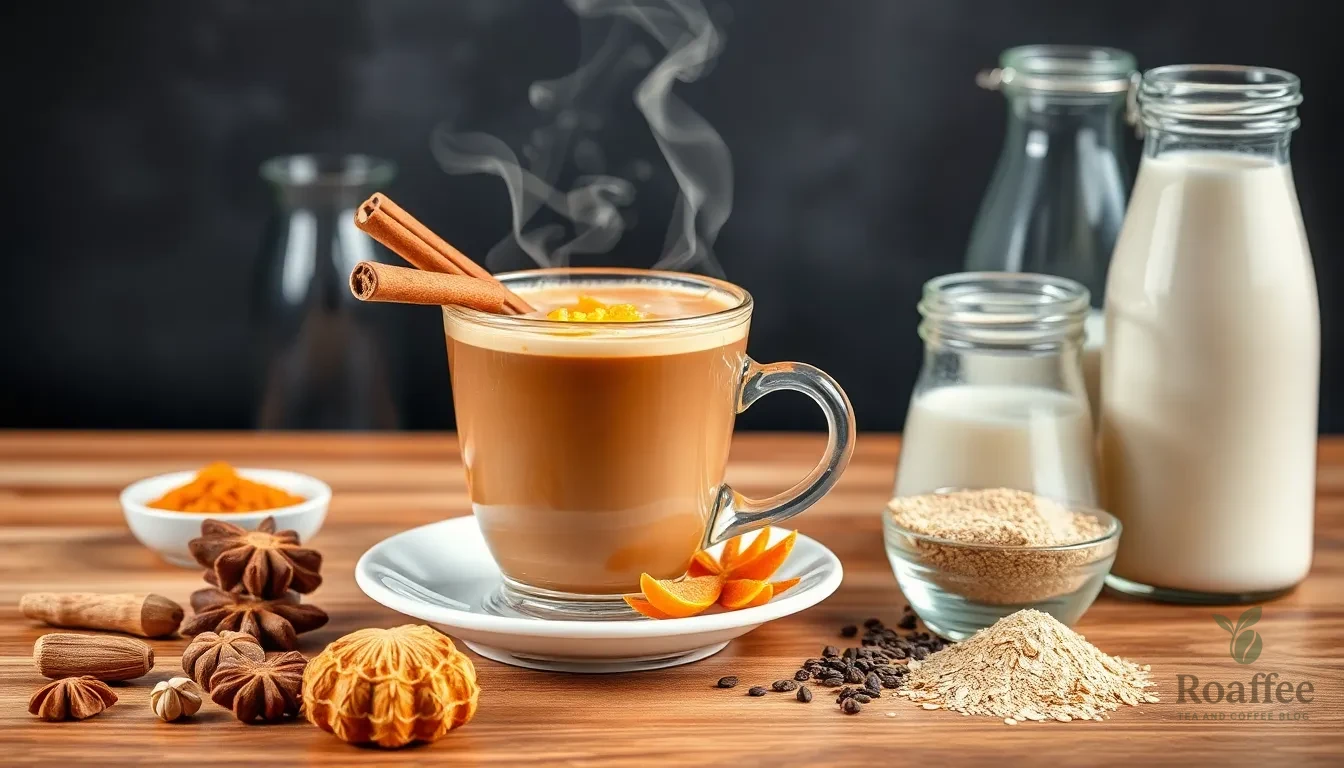
Now that we’ve mastered the fundamentals of brewing exceptional coffee at home, let’s explore ways to elevate our daily cup with creative flavor additions and dairy options.
Adding Flavors and Spices
We can transform our coffee experience by incorporating natural flavors and spices that complement rather than mask the coffee’s inherent characteristics. Cinnamon stands out as the most popular enhancement, adding warmth and subtle sweetness when we sprinkle a pinch directly into our grounds before brewing or dust it over our finished cup.
Vanilla extract creates depth and richness when we add just a few drops to our brewed coffee or incorporate it into our milk before frothing. We recommend using pure vanilla extract rather than artificial versions for the best flavor profile. Cardamom pods work exceptionally well with darker roasts, and we can crush one or two pods and add them to our coffee grounds for an aromatic Middle Eastern twist.
Nutmeg provides earthy warmth that pairs beautifully with medium roasts, while cocoa powder adds chocolate notes without overwhelming sweetness. We suggest starting with small amounts of any spice and adjusting to taste, as these additions can quickly become overpowering. Fresh ginger slices steeped in hot water before adding coffee create an invigorating morning blend that awakens the senses.
Orange zest brightens lighter roasts and adds citrus complexity when we twist fresh peel directly over our cup or mix dried zest into our coffee grounds. Star anise offers a unique licorice note that works particularly well with espresso-based drinks, while cloves provide warming spice perfect for cold mornings.
Milk and Cream Options
The choice of dairy or non-dairy additions significantly impacts our coffee’s final flavor profile and texture. Whole milk creates the richest, creamiest texture with its higher fat content, making it ideal for cappuccinos and lattes where we want substantial body and sweetness.
Heavy cream produces an indulgent, velvety texture that transforms regular coffee into a luxurious experience, though we should use it sparingly due to its intensity. Half-and-half offers a balanced middle ground, providing creaminess without overwhelming the coffee’s natural flavors, making it perfect for daily use.
Oat milk has gained popularity for its naturally sweet flavor and excellent frothing capabilities, creating microfoam that rivals dairy milk in texture and appearance. We find that oat milk complements nutty and chocolatey coffee notes exceptionally well. Almond milk offers a subtle nutty flavor that works best with lighter roasts, though its lower protein content makes it challenging to froth properly.
Coconut milk adds tropical richness and pairs beautifully with darker roasts, while soy milk provides protein content similar to dairy milk, making it excellent for creating stable foam. We recommend choosing unsweetened versions of plant-based milks to maintain control over our coffee’s sweetness level.
For temperature control, we should heat milk to 150-160°F to achieve optimal texture without scalding, which creates bitter flavors. When frothing milk at home, we can use a French press by pumping the plunger rapidly, a milk frother wand, or even a mason jar with vigorous shaking to create foam that enhances our coffee’s presentation and mouthfeel.
Conclusion
We’ve covered everything you need to transform your daily coffee routine into something truly exceptional. From selecting the right beans and mastering grind sizes to perfecting your water temperature and timing each method becomes second nature with practice.
The beauty of home brewing lies in the control you have over every variable. Whether you prefer the boldness of French press the clarity of pour-over or the convenience of drip coffee you now have the knowledge to achieve café-quality results consistently.
Remember that great coffee starts with quality ingredients and proper technique but it’s perfected through experimentation. Don’t be afraid to adjust ratios try different beans or explore new flavor combinations until you discover your perfect cup.
Your journey to exceptional home-brewed coffee begins with your very next cup. Take what you’ve learned here and start brewing with confidence knowing that each cup brings you closer to mastering this rewarding create.
Frequently Asked Questions
What equipment do I need to brew great coffee at home?
Essential equipment includes a quality burr grinder for uniform particle size, your preferred brewing method (drip coffee maker, French press, pour-over, or espresso machine), a kitchen scale for precise measurements, filtered water, and a timer. Optional tools like a gooseneck kettle, thermometer, and airtight storage containers can enhance your brewing experience and help achieve professional-level results.
How fresh should my coffee beans be for optimal flavor?
Coffee beans should ideally be purchased within two to four weeks of their roasting date for peak freshness. Always buy whole beans rather than pre-ground coffee, and grind them just before brewing to preserve maximum flavor. Store beans in an airtight container away from light, heat, and moisture in a cool, dark pantry.
What’s the proper coffee-to-water ratio for different brewing methods?
The ideal ratios vary by brewing method: French Press uses 1:15 (coffee to water), Pour Over uses 1:16, Drip Coffee Maker uses 1:15, and Cold Brew concentrate uses 1:8. Using a kitchen scale ensures accurate measurements, which is crucial for consistent flavor. These ratios can be adjusted slightly based on personal taste preferences.
What water temperature should I use for brewing coffee?
The optimal water temperature for most brewing methods is around 200°F (93°C). This temperature allows for proper extraction without over-extracting bitter compounds. If you don’t have a thermometer, bring water to a boil and let it sit for 30 seconds before brewing. Cold brew is the exception, using room temperature water.
How long should I brew coffee using different methods?
Brewing times vary by method: French Press requires 4 minutes of steeping, Pour Over takes 3-4 minutes total, Drip Coffee Maker timing depends on the machine but typically 5-6 minutes, and Cold Brew needs 12-24 hours. Use a timer for consistency and avoid over-extraction, which can lead to bitter flavors.
Why does my coffee taste bitter or sour?
Bitter coffee usually indicates over-extraction. Try using a coarser grind, lower water temperature, or shorter brew time. Sour coffee suggests under-extraction—use a finer grind, higher water temperature, or longer brew time. Also ensure your beans are fresh and your water quality is good, as both significantly impact flavor.
How should I store my coffee beans?
Store whole coffee beans in an airtight container in a cool, dark pantry away from light, heat, and moisture. Avoid refrigeration or freezing, as condensation can damage the beans. Only grind what you need for immediate use, as ground coffee loses flavor much faster than whole beans.
How often should I clean my coffee equipment?
Clean your brewing equipment after each use to prevent oil buildup that can create bitter flavors. Rinse French presses and pour-over equipment with hot water, run cleaning cycles on drip coffee makers weekly, and deep clean burr grinders monthly. Regular maintenance ensures optimal flavor and extends equipment life.
Can I enhance my coffee with flavors and milk alternatives?
Yes! Natural additions like cinnamon, vanilla, cardamom, nutmeg, or orange zest can enhance coffee’s inherent characteristics. For dairy options, try whole milk, heavy cream, oat milk, almond milk, or coconut milk. Each option affects flavor and texture differently, so experiment to find your preferred combination.
What’s the difference between brewing methods?
Each method produces distinct flavors: French Press creates full-bodied coffee with rich oils, Pour Over produces clean and bright cups, Drip Coffee Makers offer convenience and consistency, and Cold Brew delivers smooth, low-acid coffee perfect for hot weather. Choose based on your taste preferences and lifestyle needs.
